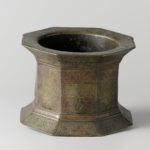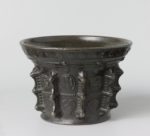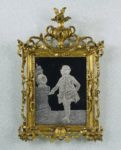 The Rijksmuseum is showcasing some of the humble magnificence from its storage depot. This group of domestic and everyday use objects haven’t been on display for at least a hundred years, overshadowed by the museum’s extraordinary collection of masterpieces.
The Rijksmuseum is showcasing some of the humble magnificence from its storage depot. This group of domestic and everyday use objects haven’t been on display for at least a hundred years, overshadowed by the museum’s extraordinary collection of masterpieces.
 They’re getting their moment in the sun thanks to the Netherlands Collection Centre , a new shared storage building currently under construction in Amersfoort which will maintain the stored treasures of the Rijksmuseum, Paleis Het Loo, the Dutch Open Air Museum and the Cultural Heritage Agency of the Netherlands all in one state-of-the-art facility. To prepare for the move, the Rijksmuseum is revising their inventory entries for each piece, taking new photographs and writing new descriptions.
They’re getting their moment in the sun thanks to the Netherlands Collection Centre , a new shared storage building currently under construction in Amersfoort which will maintain the stored treasures of the Rijksmuseum, Paleis Het Loo, the Dutch Open Air Museum and the Cultural Heritage Agency of the Netherlands all in one state-of-the-art facility. To prepare for the move, the Rijksmuseum is revising their inventory entries for each piece, taking new photographs and writing new descriptions.
 The objects range in date from the Middle Ages to the 19th century and will be displayed in five different galleries. The Middle Ages are represented by the museum’s entire collection of bronze mortars and pestles, used in pharmacology and perfume-making and for grinding spices in the home. The oldest mortar is a marquetry red copper and niello piece made in Khorasan, Persia, between 1100 and 1225. It is octagonal on the outside and cylindrical on the inside. The rest of the collection are of European, mosty Dutch, manufacture and decorated with all kinds of motifs from florals to lion heads to saints and hearts and slightly threatening studded ribs.
The objects range in date from the Middle Ages to the 19th century and will be displayed in five different galleries. The Middle Ages are represented by the museum’s entire collection of bronze mortars and pestles, used in pharmacology and perfume-making and for grinding spices in the home. The oldest mortar is a marquetry red copper and niello piece made in Khorasan, Persia, between 1100 and 1225. It is octagonal on the outside and cylindrical on the inside. The rest of the collection are of European, mosty Dutch, manufacture and decorated with all kinds of motifs from florals to lion heads to saints and hearts and slightly threatening studded ribs.
The Dutch Golden Age, so often associated with great artworks by the likes of Rembrandt, is viewed through a homier perspective in 17th century fireplace and kitchen bricks and tiles and cast iron firebacks. They performed an important function, protecting homes from areas of open flame, but that’s no reason not to make them a beautiful adornment as well. If I didn’t love my kitchen and fireplace as they are, I would be sorely tempted to get my mastic on and cover every conceivable surface with them. I mean, Scipio and Hannibal glowering at each other across a roaring fire? Yes please.
We may think of them as relatively mundane objects today, but when the mirrors in this collection were made in the 16th through 19th centuries, t hey were extremely expensive in materials, craftsmanship and human life as toxic mercury was essential to the process. This is reflected in their frames, which featured elaborate gilding, carving, molding and marquetry inlay. Some aren’t even looking glasses, but rather used as a striking medium for portraiture.
hey were extremely expensive in materials, craftsmanship and human life as toxic mercury was essential to the process. This is reflected in their frames, which featured elaborate gilding, carving, molding and marquetry inlay. Some aren’t even looking glasses, but rather used as a striking medium for portraiture.
Small in size but not in stature are textile samples from 19th and early 20th century designers. Fabric swatches by Theo Nieuwenhuis, a student of Pierre Cuypers, architect of the Rijksmuseum whose design paid a great  deal of attention to interior decoration with colorful, highly patterned wall frescoes and furnishings, are examples of the upholstery and wall textiles that once adorned Amsterdam’s Shipping House and other important city buildings. Most of the original interiors were discarded and replaced when fashions changed or they wore out.
deal of attention to interior decoration with colorful, highly patterned wall frescoes and furnishings, are examples of the upholstery and wall textiles that once adorned Amsterdam’s Shipping House and other important city buildings. Most of the original interiors were discarded and replaced when fashions changed or they wore out.
Because the Rijksmuseum is very kind to those of us not fortunate enough to have regular access to it, almost all the objects on display in this exhibition have been collected in a Rijkstudio gallery so we can browse them online.


Absolutely beautiful stuff! They need to have a look at the tile placement in the first item, though. The clouds look all wonky!
I agree with you Iris. I see what you see as being wonky. I printed out the tiled sea picture and cut out some squares and tried some other arrangement in the northwest corner. Some of the tiles are partially hidden (I assume) behind the frame so I can’t say for certain where they go. However, the third tile from the left on the top line could be rotated 90 degrees so the dark blue is on top. Then it would match the third tile on the second row if it (in turn) were rotated 90degrees so the dark blue was on the left side. That second row tile would thenmatch the the third tile on the third row. What fun!